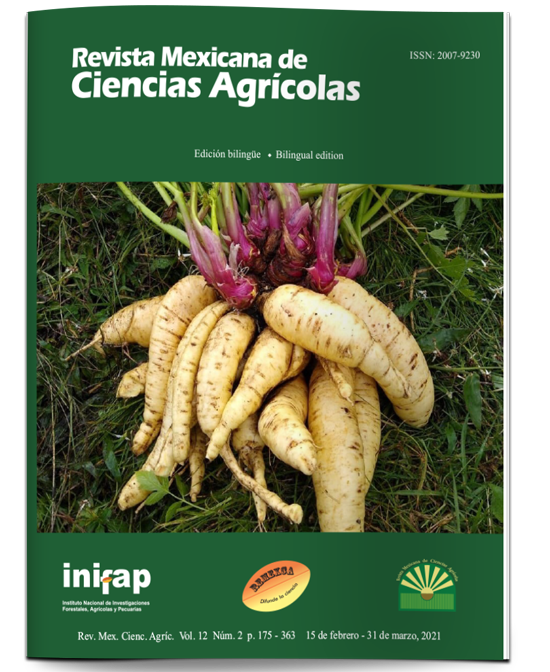Grain production and incidence of galling nematodes in common bean
DOI:
https://doi.org/10.29312/remexca.v12i2.2576Keywords:
Meloidogyne spp., Phaseolus vulgaris L., agroecosystems, cultivarsAbstract
The interaction environmental genotype in common bean crops (Phaseolus vulgaris L.) and their reaction to Meloidogyne spp., are aspects insufficiently addressed despite the influence they have on the productive results of this crop. The productive potential of five common bean crops was determined, in agroecosystems in Pinar del Río, Cuba, and the incidence of a population of Meloidogyne spp. in the vegetative phase of the crop. To this end, field experiments were established in ‘San Juan and Martínez’ and ‘Sandino’, on Ferralitic yellowish and Fluvisol soils, respectively. Commercial crops (treatments) were used: ‘BAT 304’ (commercial production witness), ‘CUL 156’, ‘Buenaventura’, ‘Delicias 364’ and ‘Chevere’. A test was also developed, under semi-controlled conditions with pots of 1. 5 kg and substrate based on ferralitic yellowish + peat soil (70% + 30%), with and without inoculation of Meloidogyne spp. (1.5 J2-eggs g-1 substrate) in the crops referred. The differences between crops and their interaction with agroecosystems showed a marked influence on grain production, although the best results were obtained with the crops ‘CUL 156’ and ‘Buenaventura’, because they exceeded by 25% the agricultural yield of the commercial production witness, in the agroecosystem of 'San Juan and Martínez’ and ‘Sandino’, respectively. It was confirmed that the cultivars evaluated are hosts of Meloidogyne spp., although ‘Buenaventura’ expressed lower infection index for the level of inoculum used, while the inverse relationship between weight and the number of guts and ootheca in the radical system of plants, suggested a harmful effect of these phytonematodes on the vegetative phase of the crop.
Downloads
Downloads
Published
How to Cite
Issue
Section
License
The authors who publish in Revista Mexicana de Ciencias Agrícolas accept the following conditions:
In accordance with copyright laws, Revista Mexicana de Ciencias Agrícolas recognizes and respects the authors’ moral right and ownership of property rights which will be transferred to the journal for dissemination in open access. Invariably, all the authors have to sign a letter of transfer of property rights and of originality of the article to Instituto Nacional de Investigaciones Forestales, Agrícolas y Pecuarias (INIFAP) [National Institute of Forestry, Agricultural and Livestock Research]. The author(s) must pay a fee for the reception of articles before proceeding to editorial review.
All the texts published by Revista Mexicana de Ciencias Agrícolas —with no exception— are distributed under a Creative Commons License Attribution-NonCommercial 4.0 International (CC BY-NC 4.0), which allows third parties to use the publication as long as the work’s authorship and its first publication in this journal are mentioned.
The author(s) can enter into independent and additional contractual agreements for the nonexclusive distribution of the version of the article published in Revista Mexicana de Ciencias Agrícolas (for example include it into an institutional repository or publish it in a book) as long as it is clearly and explicitly indicated that the work was published for the first time in Revista Mexicana de Ciencias Agrícolas.
For all the above, the authors shall send the Letter-transfer of Property Rights for the first publication duly filled in and signed by the author(s). This form must be sent as a PDF file to: revista_atm@yahoo.com.mx; cienciasagricola@inifap.gob.mx; remexca2017@gmail.
This work is licensed under a Creative Commons Attribution-Noncommercial 4.0 International license.



